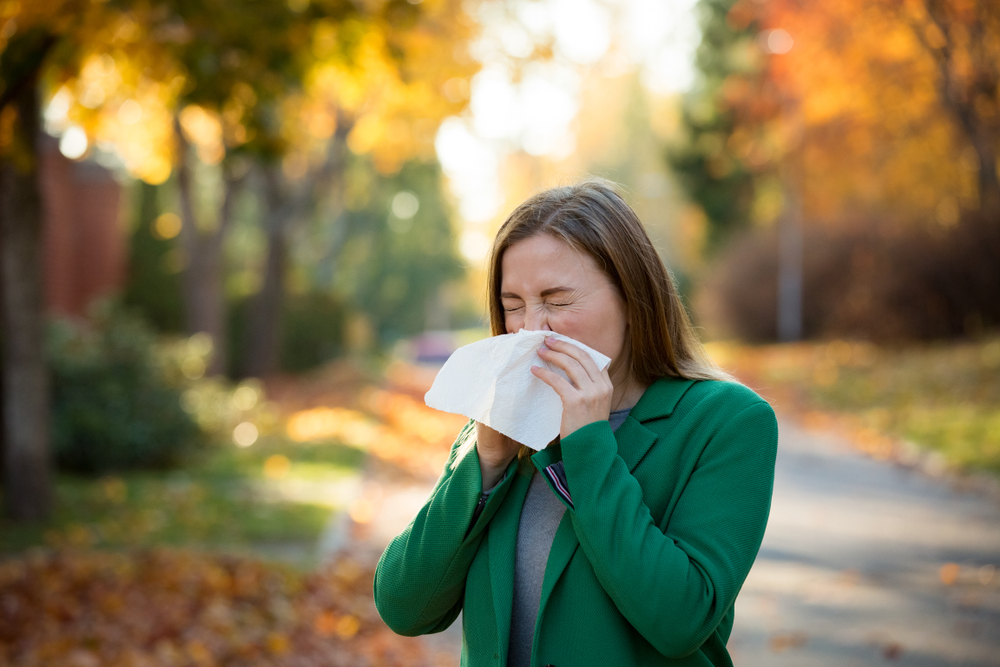As the leaves change color and the cool air of fall sets in, many allergy sufferers prepare for the seasonal discomfort that accompanies this time of year. While others may enjoy the crisp weather and pumpkin-spiced everything, fall allergy season brings unique challenges. Ragweed pollen peaks in late summer and fall, while mold from fallen leaves and dust mites thrive in cooler, wetter conditions. Fortunately, there are steps you can take to manage these specific fall allergens and minimize their impact.
How to identify and avoid fall allergens
Fall allergens differ from those in the spring and summer, so it’s important to recognize what might be triggering your symptoms. Ragweed pollen is one of the biggest offenders during the fall months, especially in the late summer through October. Additionally, mold from fallen leaves and damp conditions, along with dust mites, can worsen symptoms in fall.
Here are specific tips to avoid these fall allergens:
- Monitor Ragweed Pollen Levels: Ragweed pollen is a major fall allergen, so it’s important to track pollen counts. Use local weather reports or allergy apps to stay updated on ragweed levels. These apps often send notifications when allergen levels are high.
- Stay Indoors During Peak Ragweed Times: Ragweed pollen levels are typically highest in the morning and early evening. If you have ragweed allergies, it’s best to stay indoors during these times.
- Limit Outdoor Activities During Windy Days: Fall often brings windier conditions, which can stir up pollen and mold spores. On windy days, it’s especially important to avoid spending too much time outdoors.
- Rake and Remove Leaves Promptly: Mold spores thrive in damp, decaying leaves. To reduce exposure to mold, rake and dispose of leaves regularly. If you are sensitive to mold, it’s a good idea to wear a mask while handling leaves.
- Dry Leaves Outside: If you’re handling leaves, avoid bringing them into your home as they may carry mold spores. Try to dry leaves outside before bringing them indoors.
- Avoid Outdoor Gardening and Lawn Work: Fall is a popular time for yard work, but it can also stir up allergens like mold and ragweed. If possible, delegate these tasks or wear a mask to protect yourself.
Tips for improving indoor air quality
During the fall, mold and dust mites can flourish in your home, especially as the weather gets cooler and homes are sealed up for the season. Here are some fall-specific indoor air quality tips to reduce allergens inside your home:
- Use HEPA Filters: Install a HEPA (High-Efficiency Particulate Air) filter in your home’s HVAC system to capture pollen, mold spores, and dust mites. Also, use a HEPA vacuum cleaner to reduce indoor allergens.
- Use a Dehumidifier: Fall weather can be damp, creating ideal conditions for mold growth. Running a dehumidifier in damp areas like the basement or bathrooms can help control mold growth and reduce allergy symptoms.
- Seal Windows and Doors: Keeping your windows and doors sealed tightly during peak pollen times is crucial for preventing allergens from entering your home. Make sure to check weather stripping and seal any gaps.
- Clean Air Ducts Regularly: Dust and mold spores can accumulate in air ducts, so it’s a good idea to have them cleaned before the start of the fall allergy season.
What are over-the-counter relief options for fall allergy symptoms?
Over-the-counter treatments can help manage your fall allergy symptoms, but be sure to choose the right ones based on your specific triggers:
- Antihistamines: These medications block histamines that cause symptoms like itching, sneezing, and watery eyes. Some antihistamines are non-drowsy, which is great for daytime use. However, fall allergy sufferers often find drowsy antihistamines useful in the evening when symptoms tend to worsen.
- Nasal Sprays: Nasal corticosteroids are effective for reducing inflammation caused by mold or ragweed allergies. They can help relieve symptoms such as nasal congestion and a runny nose, common in fall allergies.
- Decongestants: For short-term relief from nasal congestion, decongestants can help by shrinking swollen nasal passages. However, use them sparingly, as long-term use can cause side effects such as increased blood pressure.
- Nasal Irrigation: Nasal irrigation with saline solution can help rinse out allergens like mold spores and pollen from your nasal passages, providing relief during peak allergy days.
When to see an ENT specialist for fall allergies
If your fall allergies are not improving with over-the-counter treatments or if they are interfering with your daily life, it’s time to consult a healthcare professional. An allergist can perform testing to identify specific allergens and create a personalized treatment plan. One common treatment is allergy shots (immunotherapy), which can gradually desensitize your immune system to allergens like ragweed and mold.
Allergy shots typically require several months of treatment but can provide long-lasting relief, making them a popular option for those with severe fall allergies.
Finding relief from fall allergies
Fall doesn’t have to be a season of misery for allergy sufferers. By understanding the specific triggers like ragweed pollen and mold, you can take proactive steps to minimize your exposure to allergens and reduce symptoms. Whether through lifestyle changes, over-the-counter treatments, or professional care, there are numerous ways to find relief. If your allergies are making it difficult to enjoy the season, consider seeing an ENT or allergy specialist for personalized treatment options that can help you breathe easier this fall.
Find an ENT specialist near you to discuss your symptoms and start enjoying fall again!
